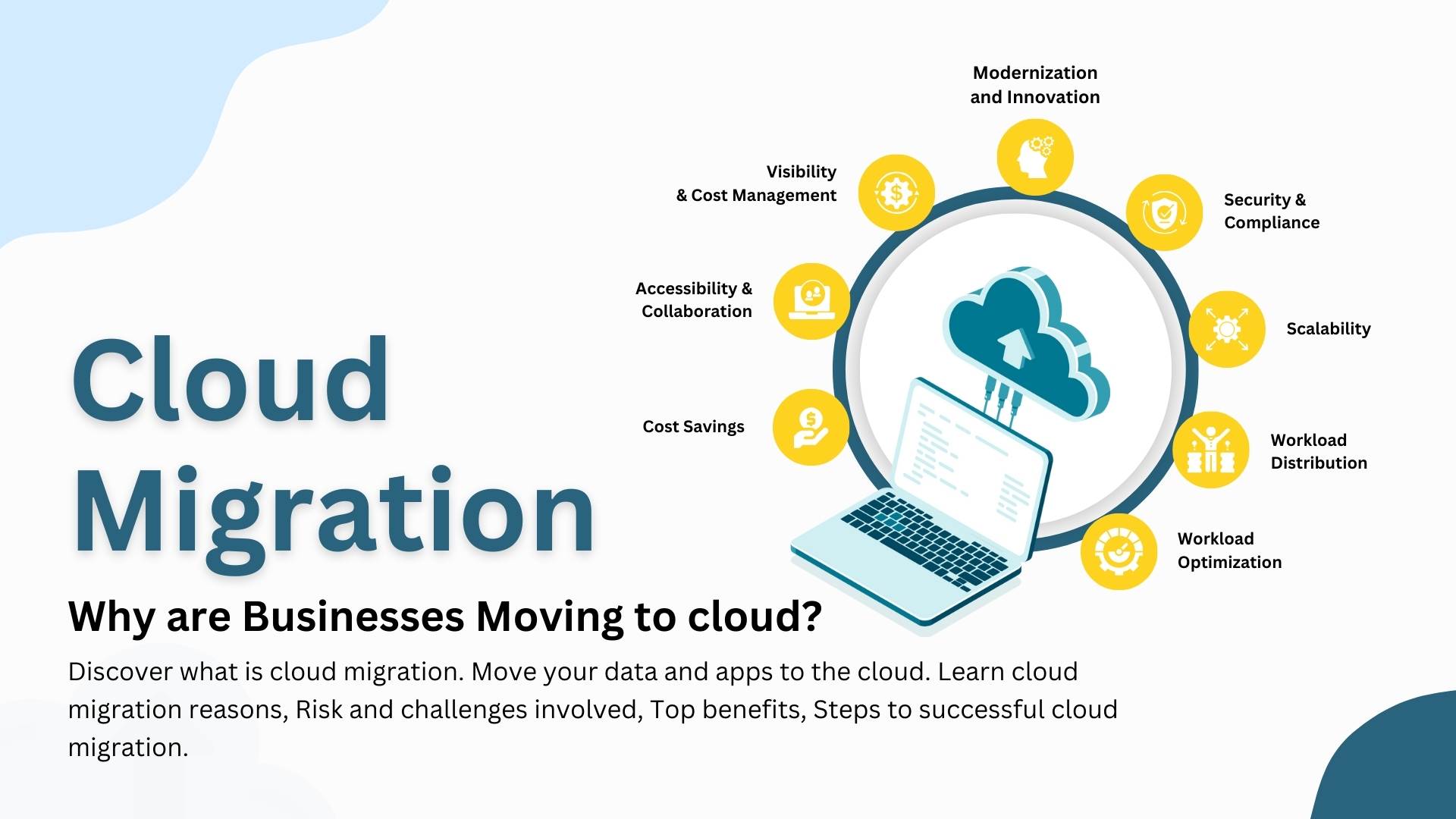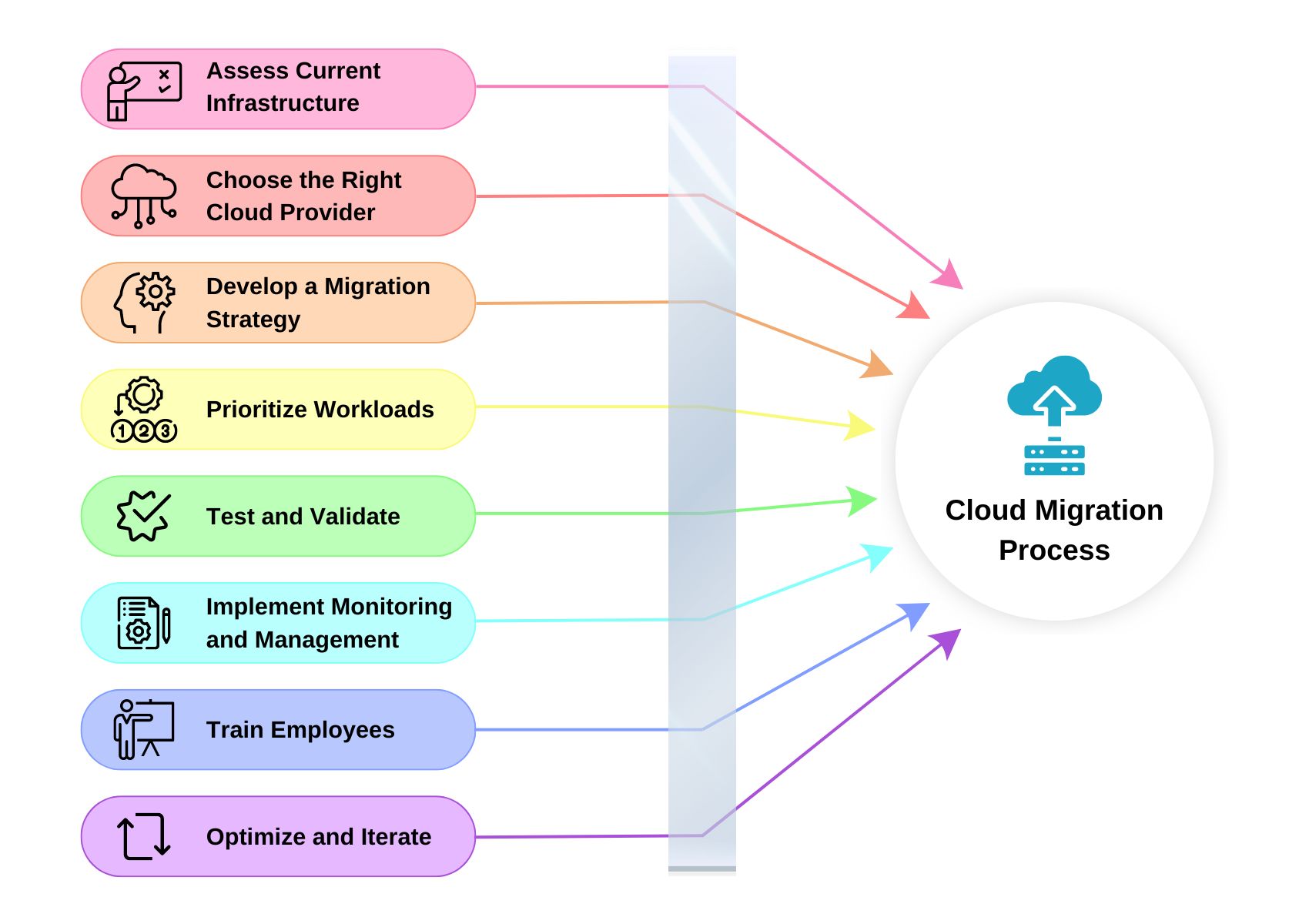“If someone asks me what cloud computing is, I try not to get bogged down with definitions.
I tell them that, simply put, cloud computing is a better way to run your business.”
-Marc Benioff, Founder, CEO and
Chairman of Salesforce
Welcome aboard as we navigate the dynamic world of cloud computing! In this interactive journey, we’ll delve into why businesses are soaring towards the clouds in 2024. Buckle up as we explore the sky-high benefits that are propelling this technological revolution.
Get ready to understand why companies are moving to cloud computing, what is migration in cloud computing, what are the benefits, risks, some simple illustrations, and more.
Why Are Companies Moving to the Cloud?
Hop on as we uncover the driving forces behind the migration frenzy. From enhanced flexibility to streamlined operations, discover why businesses are bidding farewell to traditional infrastructure, what is their goal while they explore migration in cloud computing, and embracing the boundless possibilities of the cloud.
If you think deeper, it is safe to say that why companies are moving to the cloud could be primarily associated with the rewarding nature of this phenomenon. With cloud computing, companies can scale resources up or down on-demand, ensuring optimal performance without unnecessary expenses.
This elasticity enables businesses to seize opportunities quickly and respond promptly to market changes, giving them a competitive edge in today’s dynamic business landscape.
In short, migration in cloud computing refers to the process of transferring data, applications, and other business elements from on-premises infrastructure to cloud-based services.
Companies are migrating to the cloud for several main reasons, as outlined below: –
- Scalability: Cloud platforms offer the ability to scale resources up or down quickly based on demand, allowing companies to easily accommodate fluctuating workloads without investing in additional hardware.
- Cost Efficiency: Moving to the cloud eliminates the need for upfront hardware investments and reduces ongoing maintenance costs, making it a more cost-effective option for many businesses.
- Flexibility and Accessibility: Cloud services provide remote access to data and applications from anywhere with an internet connection, enabling greater flexibility and collaboration among employees.
- Disaster Recovery and Business Continuity: Cloud providers offer robust backup and recovery solutions, ensuring that data is protected and accessible in the event of a disaster or system failure.
- Innovation and Competitive Advantage: Leveraging cloud technologies enables companies to adopt new technologies and services quickly, staying ahead of competitors and driving innovation within their industries.
Here’s a basic example to illustrate the concept:
- A small business that operates a website for selling handmade crafts. Initially, they host their website on a physical server located in their office.
- However, as their online store gains popularity, they start experiencing issues with slow loading times during peak traffic hours.
- To address this, the business decides to migrate their website to the cloud. By doing so, they can take advantage of cloud infrastructure’s scalability.
- Now, during busy periods, the cloud platform automatically allocates additional resources to handle the increased traffic, ensuring a smooth shopping experience for customers.
- As a result, the business benefits from improved performance, reduced downtime, cost effectivity and ultimately, increased sales.
What is Migration in Cloud Computing?
Prepare for liftoff as we demystify the concept of cloud migration. We’ll break down the process into digestible bits, ensuring a smooth transition as enterprises are moving towards and taking a flight to the cloud.
Migration in cloud computing refers to the process of transferring digital assets, such as applications, data, and workloads, from on-premises infrastructure to cloud-based environments. This shift enables organizations to leverage the scalability, flexibility, and cost-efficiency of cloud services to meet their business needs.
“DID YOU KNOW?”
Basically, a company moves to the cloud to save time and scale up.
To illustrate, let’s consider a company that currently stores all its files and documents on local servers within their office premises. In a traditional setup, accessing these files remotely or collaborating with team members from different locations can be cumbersome.
By migrating to the cloud, the company can upload all its files and documents to cloud storage services like Google Drive or Microsoft OneDrive. This allows employees to access files from anywhere with an internet connection, enabling seamless collaboration and productivity across the organization. Additionally, cloud migration offers benefits such as data redundancy, automatic backups, and enhanced security, further enhancing the company’s operations and resilience.
Cloud Migration Risks and Challenges
Fasten your seatbelt as we navigate through the turbulence of cloud migration risks and challenges. From data security concerns to potential downtime, we'll equip you with the knowledge to navigate the skies safely.
Amidst the excitement of cloud migration, it’s crucial to acknowledge the potential risks and challenges that may arise along the way.
One significant concern is data security, as transferring sensitive information to the cloud introduces new vulnerabilities and requires robust security measures to mitigate risks.
For example, a healthcare provider migrating patient records to the cloud must ensure compliance with stringent data protection regulations to safeguard patient confidentiality and prevent unauthorized access.
Furthermore, potential downtime during the migration process can disrupt business operations and lead to loss of productivity. It’s essential for companies to plan meticulously, implement redundancy measures, and communicate effectively with stakeholders to minimize disruptions and ensure a smooth transition to the cloud.
Apart from the above, here are a few risks involved and how they impact the process of cloud computing and an organization-
1) Reduced Visibility and Control
Without network-based monitoring and logging, organizations lose visibility into network operations, posing a challenge as they shift assets to the cloud. Compliance regulations require understanding data location and access, yet cloud services offer broad-scale user access, exposing data to potential risks.
2) Compliance
As organizations operate under regulatory frameworks, the divergence between provider-level consent and user-applied regulations poses compliance risks. In the cloud, the broad-scale user access panel can compromise data security and regulatory compliance.
3) Malware
Up to 90% of organizations risk exposure to cyber threats when migrating sensitive data to the cloud, with attackers potentially accessing data through compromised CSP credentials. Constant vigilance and security measures are essential to counter evolving cyber threats.
4) Data Deletion
Data deletion risks escalate in multitenancy environments, with over 60% of organizations citing it as a major concern. Varying deletion processes by providers and limited user insight into data location pose challenges in ensuring secure data erasure.
5) Vulnerability of Credentials
Stolen CSP credentials grant attackers’ access to private data and services, damaging both end-users and cloud credibility. Strengthening credential security and implementing multi-factor authentication are crucial in mitigating this risk.
Our Quick Fix
Additionally, we also work to mitigates risks such as malware attacks and data deletion through advanced security protocols and transparent data management practices, safeguarding client data integrity and providing peace of mind in their cloud operations.
8) Benefits of Moving to the Cloud for Businesses
Ready for smooth sailing? Discover the perks of entrusting your cloud journey to hybrid cloud services. From expert support to optimized performance, explore how managed services can elevate your business to new heights.
There’s a lot of sense in why companies are moving to the cloud and its for some REAL benefits!
Here are some REAL benefits with SHOCKING STATS of Transitioning to Hybrid Cloud Services
- Cost Savings
Cloud migration can reduce Total Cost of Ownership (TCO) by up to 40%, allowing businesses to reallocate funds towards innovation and growth initiatives (Accenture). - Scalability
The scalability of cloud infrastructure enables businesses to adapt quickly to changing demands and scale resources as needed. - Visibility and Cost Management
Despite the global cloud market surpassing $1 trillion by 2028, only 3 out of 10 organizations have clear visibility into their cloud costs, highlighting the need for improved cost intelligence and management tools (CloudZero). - Modernization and Innovation
Cloud adoption is a top priority for businesses, with a large amount of organizations planning to migrate at least half of their applications to the cloud within the next year, driving modernization and integration efforts. - Accessibility and Collaboration
Cloud-based workloads already account for better management of workloads in most organizations, enhancing accessibility and collaboration among remote teams. - Security and Compliance
Despite concerns, very few organizations plan on switching from the cloud to on- premises infrastructure, indicating confidence in cloud security measures and compliance standards. - Workload Distribution
Small and medium-sized businesses (SMBs) are increasingly relying on the public cloud, reflecting the trend towards cloud-based infrastructure. - Workload Optimization
A major chunk of businesses already run at least half of their workloads on the cloud, with the rest planning to shift the majority of their workload to the cloud in the days to come, highlighting the growing importance of workload optimization and efficiency in the cloud.
Steps to a Successful Cloud Migration
- Assess Current Infrastructure
Evaluate existing systems, applications, and data to determine what can be migrated to the cloud and identify any dependencies or constraints. - Choose the Right Cloud Provider
Select a cloud provider that aligns with your organization’s requirements, considering factors like performance, security, compliance, and cost. - Develop a Migration Strategy
Create a detailed plan outlining the migration approach, timeline, resource allocation, and potential risks to ensure a smooth transition. - Prioritize Workloads
Determine which workloads to migrate first based on factors such as complexity, criticality, and business impact to minimize disruptions. - Test and Validate
Conduct thorough testing of migrated applications and data to ensure compatibility, performance, and security in the cloud environment. - Implement Monitoring and Management
Set up monitoring tools and processes to track performance, security, and costs post-migration, optimizing resources and addressing any issues promptly. - Train Employees
Provide training and support to employees on using cloud services effectively, promoting adoption and maximizing benefits. - Optimize and Iterate
Continuously optimize cloud resources and processes based on performance metrics and user feedback, iterating to improve efficiency and cost-effectiveness over time.
Can You Afford to Ignore Cloud Migration?
Hold tight as we confront the million-dollar question: can you afford to stay grounded while your competitors soar? We’ll understand this with the simplest yet most impactful explanation, ensuring you make an informed decision that propels your business toward success.
Ignoring cloud migration in today’s digital landscape is akin to sticking to horse-drawn carriages while competitors zoom past in high-speed trains. The opportunity cost of not embracing cloud technology can be significant, leading to missed opportunities for innovation, efficiency gains, and competitive advantage.
For example, consider a small e-commerce startup that hesitates to migrate to the cloud due to perceived costs and complexities. Meanwhile, their competitors swiftly transition to cloud-based platforms, enabling them to scale rapidly, optimize operations, and offer seamless customer experiences. As a result, the startup risks falling behind in the race for market share and relevance.
By evaluating the long-term benefits of cloud migration against short-term concerns, businesses can make informed decisions that position them for success in an increasingly digital-first world.
Final Note
In conclusion, as we bid adieu to our cloud journey, remember that the sky’s the limit when it comes to leveraging cloud computing to drive innovation, agility, and success in 2024 and beyond. Embrace the clouds and watch your business soar to new heights!
Remember that it’s crucial you find the right co-pilot (by which we mean, a cloud computing services partner) when it comes to reaping the benefits of cloud computing.
Whether you’re seeking flexibility, cost savings, security, or scalability, the clouds offer endless opportunities for businesses to soar. And to help you reach these heights, we’d be delighted to join your organization on this journey of Cloud Computing!
FEEL FREE to reach out to our cloud fanatic experts and you’ll be blown away by the benefits we have to offer!











 What is XBRL: Learn the Definition, its Benefits, and Trends
What is XBRL: Learn the Definition, its Benefits, and Trends  Agentic AI vs Generative AI: What’s the Difference and Why It Matters
Agentic AI vs Generative AI: What’s the Difference and Why It Matters  The Hidden Costs of Incorrect EDGAR Filing and XBRL Tagging – And How to Avoid Them
The Hidden Costs of Incorrect EDGAR Filing and XBRL Tagging – And How to Avoid Them  What is Agentic AI and How It’s Transforming Business Operations
What is Agentic AI and How It’s Transforming Business Operations  AI Tools For Small Businesses
AI Tools For Small Businesses 